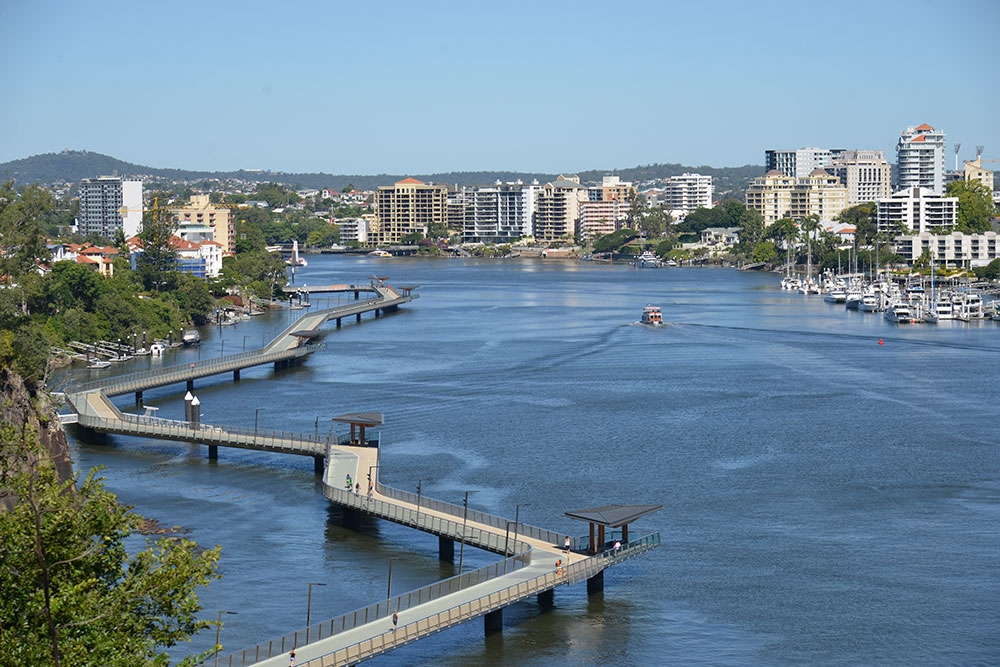Brisbane
The ultimate guide
Updated: Nov 10, 2024
Brisbane/Meeanjin is a laid back subtropical city whose character is defined by its snaking river, lush vegetation, clusters of urban villages and the tin-roofed timber Queenslanders clinging to its many hills and valleys. Rimmed by the bush-covered mountains of Brisbane Forest Park reserve to the west and extending east to the historical bayside villages with their English style beaches, it is also a gateway to the unspoilt picturesque Moreton Bay Islands and, an hour away, Australia’s holiday playgrounds the Sunshine and Gold Coasts.

Known as a lifestyle city rather than a tourist destination Brisbane is not a hotbed of iconic buildings and man-made attractions. Yet it does offer some unique showpieces, which lie sprawled along the Brisbane River. Firstly there is South Bank, the unique riverfront sprawl of tropical parklands with sandy beach, swimming lagoons, playgrounds, barbecues, eateries and bars that faces off cross river with the CBD and that extends to the cultural centre incorporating QPAC (Queensland Performing Arts Complex), Queensland Museum, State Library of Queensland, Queensland Art Gallery and Australia’s premier contemporary art gallery GOMA.

Next are the Howard Smith Wharves, an historic sprawling riverfront site nestled at the base of cliffs (reached by glass lifts) and underneath the northern pylon of the Story Bridge. which has been developed into a vibrant precinct of bars, restaurants, public spaces and an arthouse hotel, all frequented by locals and visitors alike.

The newest precinct and jewel in the crown is the Queens Wharf development on the historic North Quay area of Brisbane - a mix of soaring skyscrapers with a rooftop terrace of restaurants and bars, and below, riverside parkland and sterets of heritage-listed buildings.

Despite periods of rampant development and ever-marching suburban sprawl, decent tracts of native bush close to Brisbane’s CBD have been preserved, all with walking tracks for a cool urban escape, while the northern suburbs are traversed by a protected Mountains to Mangroves wildlife corridor. Meanwhile the CBD itself is bookended by two major public gardens – the heritage-laden City Botanic Gardens and Roma St Parkland, the largest subtropical garden in the southern hemisphere.

A tangle of riverfront walking and bike paths including the iconic overwater Riverwalk which leads from Howard Smith Wharves to New Farm have sprung up around the inner city in recent decades, making for a welcome alternative to the traffic jams that plague the city’s roads as well as a scenic leisure pursuit. And the many creeks threaded through town provide natural green belts which have been paved with shady walking and bike tracks linking suburbs and parks

Brisbane's inner city suburbs, ringing the CBD, each have their own charm and personality and are all worth a visit, from the lively former industrial sites of Newstead and riverfront woolstore precinct of Teneriffe (Brisbane's most expensive suburb) to the bohemian historic suburb of West End and the beautiful hilly suburb of Paddington, which is known for its grand Queenslanders, workers cottages, cafe and dining culture, galleries and boutiques. Must-visit is the leafy suburb of New Farm, home to Brisbane's grandest and most beautiful park, art deco apartments, majestic Queenslanders, the Brisbane Powerhouse (an historic powerhouse converted into a riverfront arts and culture hub) and reached by two riverwalks or ferries.

With a climate that is best described as lacking in wild variation or season and very predictable (the winter temperature hovers persistently around twenty while summer temperature hovers around thirty), Brisbane life is largely confined to two seasons, wet (summer) and dry (winter). The former is characterised by hot to sweltering humid days (averaging 30 degrees) and sultry nights interspersed with thunderstorms while the latter is a long stretch of mostly glorious blue-skied days (averaging 20 degrees) and chilly nights.

Whist Brisbane does not experience Spring in a traditional manner, with blooming flower gardens everywhere, Spring is instead a time of blooming trees, largely defined by Jacaranda Season, but starting with the wattles which, from late August to early September light up the streets in a blaze of yellow. These are followed by the glorious jacarandas, which bloom for a few weeks before transforming the streets in to a carpet of purple. Lastly, it's the poinciana's turn, bursting into vivid shades of red like Brisbane's very own Christmas trees in late November-early December. September-October is one of the best times to visit, with the likelihood of experiencing the beeauty of jacaranda season, before the humidity of sunmer sets in.

By the height of summer in January a kind of torpor descends and everyone heads for the beach or a pool or disappears into GOMA, an air-conditioned mall or cinema, only to re-emerge sometime in early March. The smell of back yard barbecues permeates the suburbs and beer, wine and seafood consumption climbs, while in the heat of the day only mad dogs and non-locals can be found tramping the streets.It is for this reason that the citizens of Queensland are not fans of daylight saving despite various State government's attempt to introduce it. Instead you'll find the streets and walking paths abuzz with early morning walkers, joggers and cyclists between 4.30am and 6.30am in summer, which has led to Brisbane becoming known as the early rising capital of the world.

Interestingly it is the summer factor rather than access to transport or city proximity that laid the blueprint for the socio-economic demographics of Brisbane in its early days. In the older suburbs of Brisbane it is the cool ridges and hilltops that contain the grand villas, with the smaller worker’s cottages relegated to the airless and hot valleys. And all Queenslanders were built on stilts, with wraparound verandahs and breezeways to allow maximum air flow and protect from the sun.










